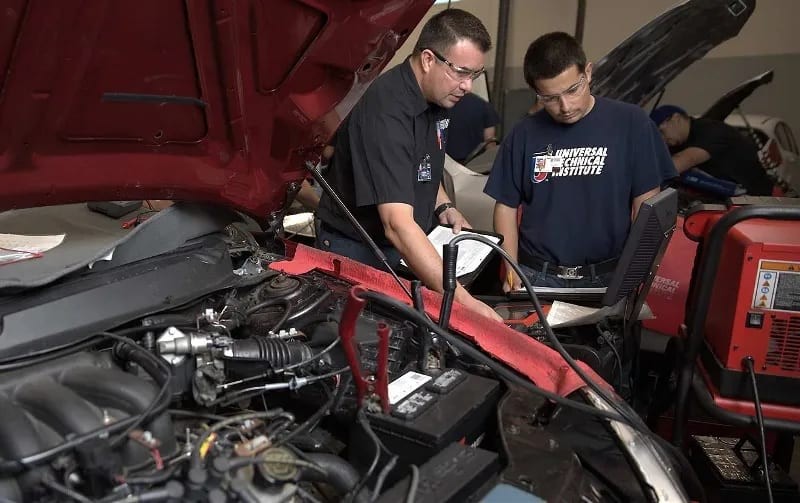Understanding how your car works can empower you as a vehicle owner and improve communication with auto repair professionals. Familiarizing yourself with the main components not only makes you a more informed consumer but also aids in basic troubleshooting and responsible car ownership.
While you don’t need to be a master mechanic, knowing the fundamental parts of your car is incredibly beneficial. This guide will walk you through the essential “Main Car Parts,” explaining their functions and importance in keeping you safely on the road.
Let’s dive into the basics and explore what’s under the hood.
The Core Components: A Car Parts Overview
Gaining a foundational understanding of the major car part names and their functions is crucial for any car owner. This knowledge will be invaluable for routine maintenance, understanding repair needs, and making informed decisions about your vehicle.
Engine
The engine is unequivocally the heart of your vehicle. Whether it’s a traditional internal combustion engine or a modern electric motor, its function remains the same: to provide the power that moves your car.
Internal combustion engines, prevalent in most cars, operate by combusting a mixture of air and fuel to generate energy. Alternatively, electric motors, increasingly common in newer vehicles, draw power from rechargeable batteries. Electric engines are known for their instant torque and quick acceleration. Regardless of the type, the engine is indispensable for vehicle operation.
Battery
Your car battery plays a multifaceted role, going beyond simply starting your engine. It’s responsible for supplying the initial electrical surge needed to ignite the engine when you turn the key. Furthermore, the battery continuously powers various electrical systems throughout your vehicle, from lighting to onboard computers.
A failing battery can leave you stranded, highlighting the importance of battery maintenance. Warning signs like a clicking sound upon ignition or dimming headlights indicate it’s time for a battery check-up.
Alternator
The alternator is the electrical generator of your car. Once the engine is running, the alternator takes over from the battery, generating electricity and simultaneously recharging the battery. This continuous charge ensures the battery remains powered and all electrical components function correctly while the vehicle is in operation.
Symptoms of a failing alternator can mirror a dying battery – dim headlights and difficulty starting the car. Ignoring alternator issues can lead to battery problems and potential breakdowns.
Brakes
Brakes are a critical safety system in your vehicle, designed to slow down, stop, and hold your car stationary when parked. Modern vehicles primarily utilize either disc brakes or drum brake systems.
Disc brake systems consist of calipers, rotors, and brake pads, while drum brakes use brake drums and shoes. All brake components are subject to wear and tear over time. Any unusual noises or changes in brake pedal feel should prompt an immediate brake inspection.
Radiator
The engine generates significant heat during operation, necessitating a cooling system to regulate its temperature. The radiator is a key component of this system. It cools down the engine coolant after it has circulated through the engine and absorbed heat, before recirculating it back to the engine to maintain optimal operating temperature.
The radiator prevents engine overheating, which is crucial for both performance and engine longevity. Regularly checking your coolant levels is a simple yet effective way to maintain your radiator and overall engine health.
Transmission
The transmission, often referred to as the gearbox, is responsible for transferring power from the engine to the wheels. It manages the engine’s power output, allowing the vehicle to move at different speeds and torques. Without a functioning transmission, the engine’s power cannot be effectively utilized to drive the wheels.
Transmissions come in manual and automatic variants. Manual transmissions require the driver to manually shift gears, while automatic transmissions shift gears automatically based on speed and engine load. Regular transmission fluid changes, as per manufacturer recommendations, are essential for maintaining transmission health and preventing premature wear.
Shock Absorbers
The suspension system, including shock absorbers, is vital for vehicle stability and ride comfort. Shock absorbers dampen the impact from road irregularities, keeping the vehicle stable and preventing excessive bouncing.
The primary function of shock absorbers is to maintain consistent tire contact with the road surface. This ensures optimal handling, braking efficiency, and overall driving safety. Worn shock absorbers can lead to a bumpy ride, vibrations, and uneven tire wear.
Catalytic Converter
As your car’s engine operates, it produces exhaust gases and emissions. The exhaust system, including the catalytic converter, is designed to manage and reduce these emissions. The catalytic converter plays a crucial role in converting harmful pollutants in the exhaust gases into less harmful substances before they are released into the atmosphere.
A malfunctioning catalytic converter can lead to reduced engine performance and decreased fuel efficiency. Maintaining a healthy catalytic converter is important for both your car’s performance and environmental responsibility.
Car Components & Their Functions: Common Questions
How are car parts identified?
Car parts are typically identified using a combination of methods to ensure accurate identification and replacement. Manufacturers assign unique part numbers to each component. You’ll often find OEM (Original Equipment Manufacturer) labels or aftermarket labels. Modern parts increasingly utilize barcodes and QR codes for efficient tracking and inventory management.
Roughly how many individual parts make up a car?
The number of parts in a typical car is surprisingly high, ranging from approximately 30,000 to 40,000 individual components. This number can fluctuate based on the vehicle’s complexity, model, and features.
Expand Your Automotive Knowledge at UTI
Eager to learn even more about the intricate world of car parts? This curiosity could be the first step towards a rewarding career as an automotive technician! Imagine working hands-on with these components daily.
At Universal Technical Institute (UTI), our Automotive Technology program offers comprehensive training to equip you with the skills to service and repair both domestic and import vehicles. We also provide specialized training programs in partnership with leading automotive brands. From engine diagnostics to advanced emissions control, our courses offer hands-on experience and industry-relevant knowledge to prepare you for a successful career in the automotive field.
Our programs are designed to be completed in less than a year, allowing you to quickly gain the education and skills needed to pursue your passion. Get ready to turn your interest in cars into a fulfilling and in-demand profession!
Ready to take the next step? Request more information from our Admissions Representatives or call 1-800-834-7308 to learn more about UTI and our automotive programs.
UTI Campuses Offering Automotive Technician Programs
[Start your mechanic or technician career today! Classes begin every 3-6 weeks. Get hands-on training with top brands. No pressure to commit – get your questions answered.]
Explore Related Articles
[
Advancing vs. Retarding Ignition Timing: Key Differences](/blog/automotive/ignition-timing) Ignition timing’s impact on engine performance explained.
[
The Difference Between an Automotive Mechanic and an Automotive Technician](/blog/automotive/the-difference-between-a-mechanic-and-an-automotive-technician) Understand the distinctions between these auto careers.
[
ASE Certification: Your Guide to Becoming ASE Certified](/blog/tips/mechanic-path-ase-certification) Learn how ASE certifications can boost your automotive career.
]
Disclaimer: UTI is an educational institution and cannot guarantee employment or salary. For program outcome information and other disclosures, visit www.uti.edu/disclosures. Some programs may take longer than one year to complete. UTI offers blended learning formats with online and hands-on lab training.

